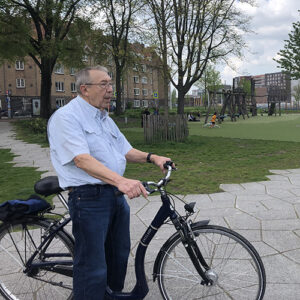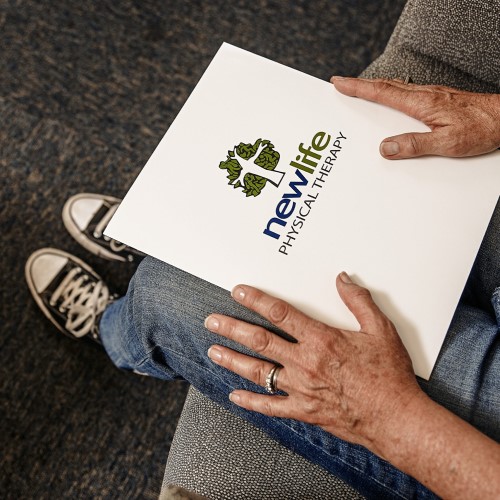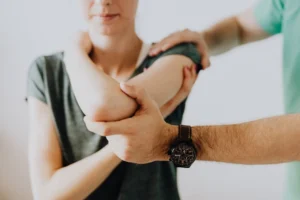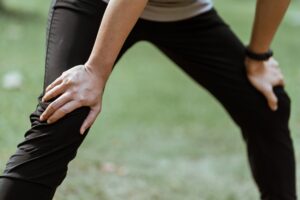On Wednesday, April 24, 2024 from 5:30pm-6:30pm, we are hosting a FREE Shoulder Pain Workshop [ Online
] - Click here for more info
Frank L’s Story

The exercises seem to be helping even though we didn’t have much time before I left on vacation. Becki was very helpful, giving me exercises to work on. She was great.
– Frank L
Lunge Matrix

The Power of Protein: Fueling Muscles, Healing, and Beyond

Protein is a powerhouse nutrient, playing a crucial role in building muscle, aiding in injury recovery, supporting weight loss, and offering a host of other health benefits. Its importance in our diet cannot be overstated, especially for those looking to enhance their physical health and overall well-being. Let’s dive into why protein is so essential, particularly for muscle building, injury recovery, and weight loss, along with its other remarkable benefits.
Protein is often hailed as the building block of muscles. Engaging in strength training or any form of exercise that stresses the muscles leads to tiny tears in muscle fibers, which the body repairs and rebuilds stronger than before. This process is known as muscle protein synthesis, where protein plays a starring role. Consuming adequate protein ensures your body has the necessary amino acids to repair and grow muscle tissue, making it essential for anyone looking to increase muscle mass or enhance muscle tone.
When it comes to healing from injuries, protein takes center stage again. After an injury, the body’s demand for protein increases to repair damaged tissues. Adequate protein intake provides the body with the amino acids needed to build new tissue, reduce recovery time, and ensure a stronger regrowth of muscle fibers. This is particularly crucial for athletes or individuals recovering from surgeries or wounds, as a protein-rich diet can significantly impact the speed and quality of recovery.
In the realm of weight loss, protein is a key ally. High-protein diets are often more satisfying, making you feel fuller for longer and reducing the likelihood of overeating. Protein has a higher thermic effect than fats or carbohydrates, meaning your body uses more energy to digest it, boosting your metabolism in the process. By preserving muscle mass, even as you lose fat, protein helps maintain a healthy metabolism, essential for long-term weight management.
The benefits of protein extend far beyond muscle building, injury recovery, and weight loss. Here are a few additional reasons to ensure you’re getting enough protein in your diet:
The amount of protein you need depends on various factors, including age, sex, physical activity level, and health goals. The general guideline is 0.8 grams of protein per kilogram of body weight for the average adult, is often suggested to be insufficient for optimal health. It could be enough to life but not necessarily thrive. More recent studies show that people should consider closer to two grams per kilogram, or about one gram per pound of body weight. It’s always a good idea to consult with a healthcare professional or a registered dietitian to determine your specific protein needs.
Incorporating protein into your diet can be easy and delicious. Sources of high-quality protein include lean meats, poultry, fish, dairy products, eggs, legumes, and plant-based alternatives like tofu and tempeh. For those on the go, protein shakes and bars can offer a convenient way to meet your protein needs. Just consider the total amount of sugar and calories when choosing what may be the best for you.
Protein is an essential nutrient that supports muscle building, injury recovery, weight loss, and much more. By understanding its importance and ensuring you’re consuming adequate amounts, you can support your body’s needs, promote overall health, and achieve your fitness goals. Remember, a balanced diet that includes a variety of nutrients, along with regular exercise, is the key to a healthy lifestyle.
Tennis Elbow and Tendonitis

Let’s talk about something called “tennis elbow” and some issues that can happen with tendons, which are super important because they connect our muscles to our bones and help us move around. Imagine tendons like strong, stretchy bands that help you do everything from picking up your backpack to throwing a ball. But sometimes, they can get hurt or not work right, which can lead to pain and trouble moving.
First up is tennis elbow, which happens when the tendons in your forearm (the part of your arm from your elbow to your wrist) get irritated or hurt. This can happen if you play a lot of tennis or do the same arm movements over and over again, like painting or using tools. If you have tennis elbow, you might notice:
Then there’s something called tendonosis, which is a bit different. It’s not about the tendon being swollen or inflamed from an injury or doing too much all at once. Instead, tendonosis is about the tendon getting worn out over a long time. This can make the tendon weaker and less stretchy because it’s not getting enough blood flow. If you have tendonosis, you might feel:
So, tennis elbow can happen because of tendonitis or tendonosis. The big difference is that tendonitis is when the tendon gets swollen and sore right after getting hurt or used too much, while tendonosis is when the tendon slowly gets worn out over time. Tendonosis doesn’t really get swollen like tendonitis does, but it can make the tendon hurt and not work as well.
Both of these problems can make your arm hurt and make it tough to do everyday things, but they happen for different reasons and need to be taken care of in different ways.
Simply ignoring the problem and hoping it will get better on its own is often not the way to approach these problems. The longer you have the issue, the longer it will take to fully address and recover from the pain and problems you experience. This has to do with the change in actual cellular makeup of the tendons that we discussed above and the length of time it takes to reverse that process.
The good news…physical therapy has strong evidence showing it can help.
Cortisone injections have been found to not be very effective, and in fact, in reviews research suggests that participants studied who received cortisone injections are worse after 12 months compared to those who did not receive the injection. This can weaken the tendon further, especially with repeat injections, and therefore should be considered with caution and only if other evidence-based care and appropriate length of healing time has passed without improvement or change.
There is newer evidence emerging showing that dry needling combined with electrical stimulation in a specific pattern and protocol is effective at treating these stubborn tennis elbow situations. Our entire New Life PT team went through training on this updated protocol mid-February 2024 and are able to speak with you on whether or not you are a candidate for this treatment. If you have been seen prior but did not have this treatment performed, reach out to see if this is an option for you at this time.
Tennis elbow is a complex situation and simply following a few exercises found off the internet is not enough to fully address all the factors that go in to causing it. There is no one-size-fits-all approach that works for majority of people. It is an individualized problem that must be met with an individualized solution.
Finally, these situations require a lot of time and patience. It did not get this way overnight, and it will not improve overnight. One suggestion we have is to journal out and write down your symptoms – when they really began, current – where you feel the pain, with what activities, at what intensity, constant vs. intermittent, etc. Throughout your treatment over the course of several months continue to journal these items as sometimes small changes aren’t always evident right away but when you look back at where you have come from, you can more clearly see them. A generally rule of thumb on expectations is take how long you have been dealing with the problem, and double it. That is how long it could take to fully address and see resolution of symptoms. Example, if you have been dealing with tennis elbow problems for 3 months, it could take up to 6 months to fully be back to your “normal”.
This also speaks to the importance of not letting the problem go too long without getting it looked at. New Life PT accepts patients via direct access, so no referral needed from your provider to get started. If your insurance requires one, come in and see us, we will help you get one on your behalf after your initial evaluation.
Patellar Tendinitis Education

Patellar tendinitis or “jumper’s knee” is inflammation of your patellar tendon which is the connection between your knee cap and your shin bone. This tendon is designed to transfer the force from your quadriceps (or thigh muscle) to the lower leg the provide movement or support, such as during walking, running, jumping, or squatting. With high levels of repetitive loading/stress on the tendon, beyond what the tendon is capable of handling, the tendon can become irritated and inflamed. This is typically felt as pain at the front of your knee which worsens with impact activities (such running or jumping) or repetitive loading (such as stairs or squatting or rising from a chair).
Risk factors for developing patellar tendinitis include repetitive impact activities, poor movement patterns, stiffness or tightness around knee joint, weakness of leg or hip muscles, or increasing training/activity too quickly.
Treatment initially is focused on reducing the acute pain and swelling via ice and anti-inflammatories (if needed). A short pause in participating in the aggravating activity/sport may be recommended to allow healing. Physical therapy and exercise are the gold standard for treating patellar tendinitis. A combination of mobility and strengthening activities will be used to ensure the knee joint, and therefore the patellar tendon, are moving appropriately. Depending on activity or your goals, a running or jumping analysis can be performed to determine if movement patterns need to be modified. Once symptoms have improved, progressive activity is reintroduced to ensure tolerance.
During recovery or when symptomatic, a patellar strap can be worn over the patellar tendon. This strap acts as a counterforce to take stress off of the attachment points of the tendon this reducing irritation. This is typically worn during sporting activities, but can be used daily if needed.
The most important part in treating patellar tendonitis is determining why it happened to begin with. Many times the tendon doesn’t just start to get inflamed without more stress or strain being put on it. Potentially from flat feet, tightness in heel bone or limited hip motion and weakness. Figuring out what, biomechanically, caused increase stress to that area to cause the initial inflammation is ultimately going to ensure long-term success. If you have been treated for this condition in the past, and your provider did not consider the deeper root cause of the problem, it may be worth having another evaluation looking at that.
If you or someone you know is dealing with patellar tendinitis, and are not noticing improvement, consider scheduling an evaluation with a New Life Physical Therapist to evaluate and develop a personalized treatment plan.
Patellar Tendinitis: Causes & Treatment

Patellar Tendinitis or “jumper’s knee” is inflammation of your patellar tendon which is the connection between your knee cap and your shin bone. This tendon is designed to transfer the force from your quadriceps (or thigh muscle) to the lower leg the provide movement or support, such as during walking, running, jumping, or squatting. With high levels of repetitive loading/stress on the tendon, beyond what the tendon is capable of handling, the tendon can become irritated and inflamed. This is typically felt as pain at the front of your knee which worsens with impact activities (such running or jumping) or repetitive loading (such as stairs or squatting or rising from a chair).
Risk factors for developing patellar tendinitis include repetitive impact activities, poor movement patterns, stiffness or tightness around knee joint, weakness of leg or hip muscles, or increasing training/activity too quickly.
Treatment initially is focused on reducing the acute pain and swelling via ice and anti-inflammatories (if needed). A short pause in participating in the aggravating activity/sport may be recommended to allow healing. Physical therapy and exercise are the gold standard for treating patellar tendinitis. A combination of mobility and strengthening activities will be used to ensure the knee joint, and therefore the patellar tendon, are moving appropriately. Depending on activity or your goals, a running or jumping analysis can be performed to determine if movement patterns need to be modified. Once symptoms have improved, progressive activity is reintroduced to ensure tolerance.
During recovery or when symptomatic, a patellar strap can be worn over the patellar tendon. This strap acts as a counterforce to take stress off of the attachment points of the tendon this reducing irritation. This is typically worn during sporting activities, but can be used daily if needed.
The most important part in treating patellar tendonitis is determining why it happened to begin with. Many times the tendon doesn’t just start to get inflamed without more stress or strain being put on it. Potentially from flat feet, tightness in heel bone or limited hip motion and weakness. Figuring out what, biomechanically, caused increase stress to that area to cause the initial inflammation is ultimately going to ensure long-term success. If you have been treated for this condition in the past, and your provider did not consider the deeper root cause of the problem, it may be worth having another evaluation looking at that.
If you or someone you know is dealing with patellar tendinitis, and are not noticing improvement, consider scheduling an evaluation with a New Life Physical Therapist to evaluate and develop a personalized treatment plan.